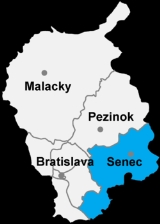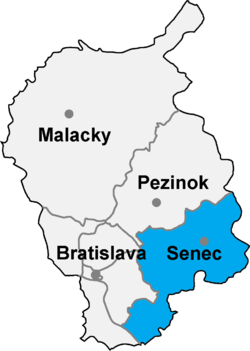
Dunajská Lužná
Encyclopedia

Bratislava Region
The Bratislava Region is one of the administrative regions of Slovakia. Its capital is Bratislava. It is the smallest of the eight regions of Slovakia.-Geography:...
of western Slovakia
Slovakia
The Slovak Republic is a landlocked state in Central Europe. It has a population of over five million and an area of about . Slovakia is bordered by the Czech Republic and Austria to the west, Poland to the north, Ukraine to the east and Hungary to the south...
in Senec District
Senec District
Senec District is a district inthe Bratislava Region of western Slovakia. Until 1918, the district was part of the Hungarian county of Pressburg.-Municipalities:*Bernolákovo*Blatné*Boldog*Čataj*Dunajská Lužná*Hamuliakovo...
.
Dunajská Lužná lies approximately 15 km from the capital city of Bratislava
Bratislava
Bratislava is the capital of Slovakia and, with a population of about 431,000, also the country's largest city. Bratislava is in southwestern Slovakia on both banks of the Danube River. Bordering Austria and Hungary, it is the only national capital that borders two independent countries.Bratislava...
towards Dunajská Streda and Komárno. She was founded on 1 January, 1974 consisting of three formerly separate villages - Nové Košariská (former German name was Mischdorf, former Hungarian name was Mišérd), Jánošíková (former name Dienesdi or Dénešd) and Nová Lipnica (former German name Tartsendorf, former Hungarian name Torč). Dunajská Lužná belongs to the vicinity of Bratislava. There is increasing building activity due to new inhabitants coming from Bratislava or other cities.
Not far from the municipality towards Senec lie two lakes - Malá Voda and Piesková Jama. They serve for fishing and also for bathing and in Summer months they are quite crowded. Near the township runs a dam, protecting the villages and townships all the way from Bratislava to Gabčíkovo
Gabcíkovo
Gabčíkovo is a municipality in Slovakia. It has around 5,100 inhabitants of whom 90% are Hungarians.The Hungarian name of the village was first recorded in 1102 as Beys and preserves the name of its erstwhile pecheneg inhabitants, pecheneg being besenyő in Hungarian...
from flooding from the Danube
Danube
The Danube is a river in the Central Europe and the Europe's second longest river after the Volga. It is classified as an international waterway....
River. The inhabitants of Dunajská Lužná are of a mixed nationality, represented mainly by Slovaks, but with Germans, Hungarians, Roma and several other groups present as well. The current status of population here is around 3200 (as of December, 2005).
There is a large Roman Catholic community in Dunajská Lužná with the Church, devoted to "The Elevation of the Holy Cross". Besides Roman Catholics there are also Lutherans and other religions.
History
The village crest shows St. Martin of Tours.The municipality of Dunajská Lužná is also well known in European archaeology for its burial mound which dates from around 700 - 500 BCE. During the archaeological survey in the "Nové Košariská" part of the municipality, a necropolis with fire-type burials and a central earth-grave was studied. Archaeogolists found richly decorated ceramic bins here, although only few metallic objects were retrieved.
In January 2004, a permanent exposition with the name "History and present of the municipality" was opened in Dunajská Lužná and it provides visitors with closer view of the past and present life of the Township.
Demographics
Due to its proximity near Austria and Hungary the village boasts a strong ethnic mix, with up to fourteen different nationalities calling the village home.One of these is Dunajská Lužná's strong Roma population, which is renowned for their skills as blacksmiths, and much of the ironwork seen in and around Bratislava is the craft of these smiths.

